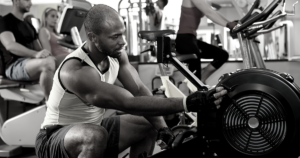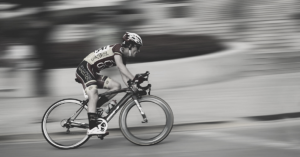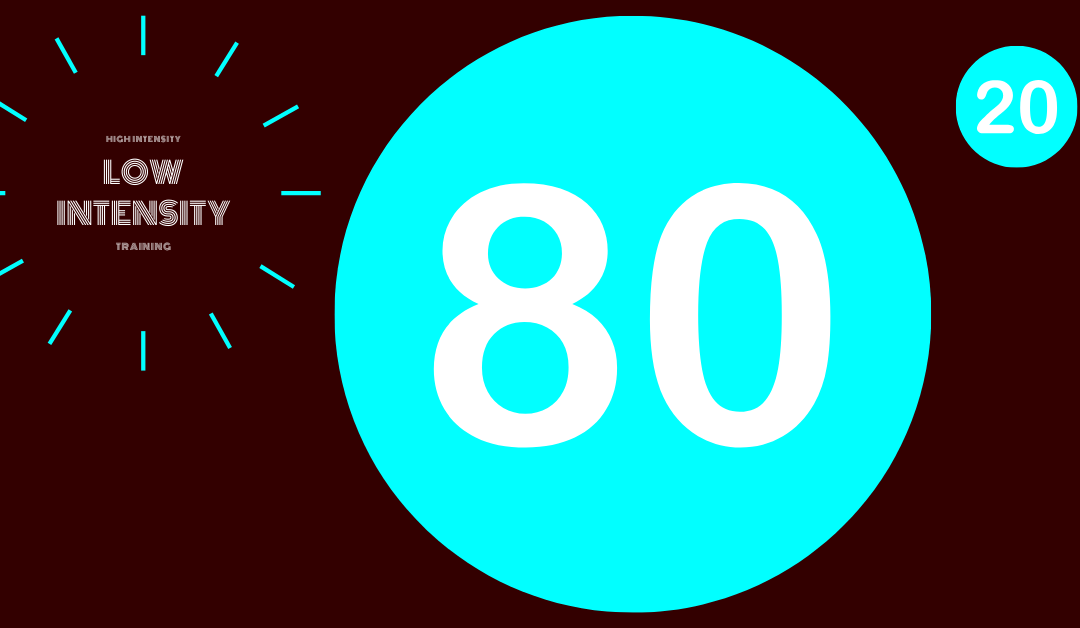LOWER INTENSITY = IMPROVED FITNESS!
Are you a high intensity lactic acid loving pain train thrill seeker or a steady state mileage king plodder racking up the training hours or maybe you incorporate both in an 80 20 polarised training plan.
Can you get greater fitness gains by training less at a higher intensity? How about sweet spot or anaerobic threshold training? Train harder for longer? Limit your sessions and get better results? Or forget high intensity and target the miles, clocking up the hours? Is there a correct way to train for endurance athletes?
hours? Is there a correct way to train for endurance athletes?
I have been endurance training for over 35 years and have been luckily enough to be coached by some great coaches. All with different ideas on training programmes. Some worked better than others. All got me fit and strong, but others seem to work better for longevity and peak performance. Some programmes I improved and then plateaued. One programme even burnt me out through over-training.
Firstly, let’s categorised endurance training. Anything longer than a race of 40 seconds is considered an endurance sport. My sport, rowing has an Olympic racing distance of 2000 metres which has a time of just over 5 minutes and under 8 minutes depending on the boat you row in and weather conditions.
If you’re an indoor rower, the 2000 metre distance can take just under 6 minutes to over 10 minutes depending on fitness, strength, age, sex and ability.
 80 20 polarised training has been popularised by Matt Fitzgerald, an endurance journalist and coach who has written some great books on 80/20 training.
80 20 polarised training has been popularised by Matt Fitzgerald, an endurance journalist and coach who has written some great books on 80/20 training.
So what is 80 20 polarised training?
80 20 POLARISED TRAINING
80 20 was first researched by Stephen Seiler, an American exercise scientist based in Norway. Whilst in Norway studying endurance athletes from different sports, Seiler discovered training similarities between the top endurance athletes, whether runners, rowers, cross-country skiers, triathletes or cyclists.
Seiler found approximately 80% of training of the Norwegian endurance athletes was at low intensity, between 60-70% of maximum heart rate (zone 2) and 20% at 85+% of maximum heart rate (zone 4 and 5).
Paula Radcliffe followed a 80 20 polarised training programme at her peak in 2003 when 12 of her 15 runs totalling 160 miles a week over 8 days would be in zone 2.
Sounds great! How do I set my intensities?
LOW INTENSITY EXERCISE – THE 80%
Low intensity exercise is performed at less than 2 millimoles per litre of blood lactate (<2mmol/L) which equates approximately 60-70% of your maximum heart rate (zone 2).
There are several formulas on how to work out your maximum heart rate (MHR). 220-age is the most common. Another measurement is 207-(0.7 x age). Do not use these. They can be and often are inaccurate.
The best method is to perform a step test. You should always consult your doctor before performing a maximum fitness test. In addition, you should always use the machine in which you race or train on.
There are many different types of step tests for different sports. This is the procedure for a rower or someone who trains frequently on the rowing machine.
Test: Rowing example. Based on a recent 2000m test of 6 minutes 20 seconds (410 watts). Perform seven 4 minute steps starting at a slow easy pace. The first six 4 minute steps are rowed continuously. At the end of the sixth set, rest for 1 minute and perform a 4 minute max test at 2000m race pace or quicker. At the end of the final step, review your heart rate data for the highest value sustained for 5 seconds. Use this as your maxumum heart rate (MHR).
Based on a rower who completes 2000 metres between 6 minutes 10 seconds and 6 minutes 20 seconds.
Between steps 6 and 7, rest for 60 seconds.
Working out heart rate zones:
Now you have your maximum heart rate (MHR), you need your resting heart rate (RHR). Measure RHR first thing in the morning before getting out of bed.

To find out your training zones: MHR – RHR x percentage of zone + RHR (eg 172-44=128×0.60=76.8+44=120.8)
60% zone 2 low intensity training starts at 121bpm
Zone 1: 50-60% of MHR Zone 2: 60-70% of MHR Zone 3 70-80% of MHR Zone 4 80-90% of MHR Zone 5 90-100% of MHR
Completing ‘easy’ zone 2 sessions too hard will result in fatigue, plateau in performance, overtraining and possible injury. It will also affect your ability to perform the hard quality workouts.
Zone 3 heart rate training (70-80% of MHR) and also known as the ‘grey zone‘ is commonly what heart zone most recreational athletes train in.
The problem with zone 3? It’s above aerobic pace and has some lactate response. It isn’t hard enough to benefit from high intensity exercise, yet it is too hard to allow for day to day recovery.
BENEFITS OF ZONE 2 TRAINING
- increase aerobic capacity
- stimulate type 1 muscle fibres and maximising mitochondrial growth and density
- increase fatty acid usage making you super efficient at burning fats and preserving glycogen stores
- improves lactate clearance during intense exercise
HIGH INTENSITY EXERCISE – THE 20%
Many recreational endurance fitness athletes feel like they must go hard every workout. Training in zone 3 is very common. How often have you gone for a 60 minute run in zone 3 for the whole workout. Next day, you wake up exhausted, but it’s a zone 5 day and you struggle to motivate and complete the workout properly. Result. Training effect is lost, leading to exhaustion, under-performance and lack of motivation. Sounds familiar!
 And there is the steady state miles miles miles zone 1 athlete. The athlete claiming bragging rights to clocking up the most miles in a week. You know the ones! Training for hours and hours with no speed work or performance workouts to gauge progress. Sitting in zone 1 wasting hours. To enable physiological adaptations in endurance sports, you need to be at a minimum of 60% of MHR (start of zone 2).
And there is the steady state miles miles miles zone 1 athlete. The athlete claiming bragging rights to clocking up the most miles in a week. You know the ones! Training for hours and hours with no speed work or performance workouts to gauge progress. Sitting in zone 1 wasting hours. To enable physiological adaptations in endurance sports, you need to be at a minimum of 60% of MHR (start of zone 2).
Then, when you hit a zone 5 workout, you’ll be fresh and ready to train hard. Polarised training allows this. You should feel excited at the prospect of moving quickly and performing well just before the zone 5 session. If you want to get fitter and faster, everything in the middle (zone 3) is going to slow you down.
Zone 4 workouts tend to be around the anaerobic threshold heart rate which is when you reach approximately 85% of your MHR.
Zone 4 training should consist a total work time of 30-40 mins of the workout. These can be done in intervals or single bouts of exercise.
BENEFITS OF ZONE 4 TRAINING
- improves speed endurance, anaerobic capacity and threshold
- improves efficiency of using carbohydrates for energy
- tolerate higher levels of lactic acid in the blood
The next level is zone 5 which is 90+% of your MHR. This is the top end of endurance exercise. Your total training time will be 15-20 minutes, broken down into intervals with equal rest. If you’ve been training in zone 3 the day before, you’re going to struggle with zone 5.
BENEFITS OF ZONE 5 TRAINING
- increase power, speed and endurance
- improves VO2max (maximal amount of oxygen that can be inhaled and absorbed by the body)
- lowers blood lactate levels during high intensity exercise
- increase stroke volume of heart
- increase mitochondrial enzyme activity
GUIDELINE, OT STRICT RULE
There is room for manoeuvre in the 80/20 rule. You can train at 75/25, 85/15 or 90/10 and still benefit from the polarised programme. It also changes with the training phases of the year and when your peak race is.
 Recently, I’ve been raising money for the NHS during the Covid-19 pandemic. I currently teaching three zone 5 workouts a week on Zoom with other rowers. As a result, my performance has plateaued and I’m also underperforming on at least one of the workouts.
Recently, I’ve been raising money for the NHS during the Covid-19 pandemic. I currently teaching three zone 5 workouts a week on Zoom with other rowers. As a result, my performance has plateaued and I’m also underperforming on at least one of the workouts.
I know I’m doing too much high intensity, but it’s for a good cause and short-lived. I will soon be back to 2 high intensity and 4 low intensity workouts a week.
And remember it’s about time, not sessions.
 My 6 sessions a week (4 low intensity and 2 high intensity) would equate to 66/33 split if counting sessions. Hardly polarised. But when you take into account the time, it’s a polarised split. If we add my total training hours up over a week which is 360 minutes. Of that, 300 minutes is in zone 2 and 60 minutes in zone 5. That equates to a 83/17 split. Definitely polarised.
My 6 sessions a week (4 low intensity and 2 high intensity) would equate to 66/33 split if counting sessions. Hardly polarised. But when you take into account the time, it’s a polarised split. If we add my total training hours up over a week which is 360 minutes. Of that, 300 minutes is in zone 2 and 60 minutes in zone 5. That equates to a 83/17 split. Definitely polarised.
My days of zone 5 are separated by three days for maximum recovery. I complete one session of high intensity rowing on a Monday and one session on a Friday. Everything else is in zone 2. This allows for recovery between hard days allowing my body to be prepared.
And sleep and recovery are paramount for improvement.
PATIENCE
The 80 20 polarised training method is the best way to improve performance, longevity and health. It’s for all endurance athletes, whether young or old, amateur, professional or weekend warriors.
 There is so much temptation to ‘smash’ every session, especially with the lockdown and the emergence of online training apps such as Strava and Zwift. These actively encourage people to continually race every session. Recipe for burn-out.
There is so much temptation to ‘smash’ every session, especially with the lockdown and the emergence of online training apps such as Strava and Zwift. These actively encourage people to continually race every session. Recipe for burn-out.
Remember, too much intensity will cause burn-out or injury or both.
My message. Relax. Enjoy the scenery on a long bike ride, row, or run or listen to a good podcast on the turbo trainer or rowing machine. Let someone overtake you and blast off. Keep that intensity down. Avoid the ‘grey zone‘. It’s not for you today.
Then, on a zone 5 day, unleash your full potential.

